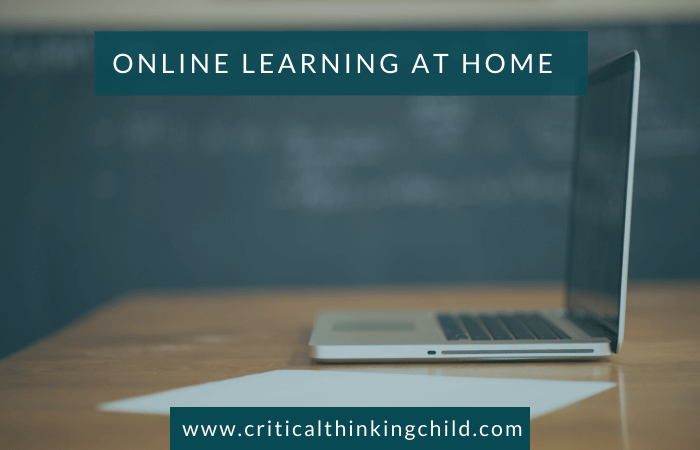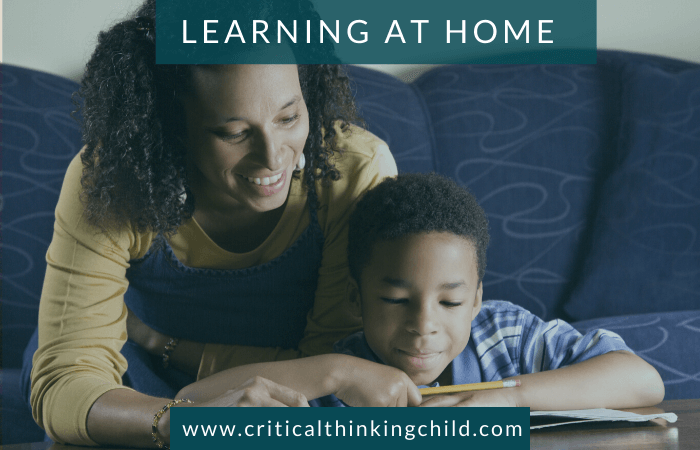It’s an uncertain time. Coronavirus concerns persist, and many schools, districts, and parents have turned to e-learning for their kids for the foreseeable future. Whether children are at home full time or part time, this puts additional stress on parents and students alike.
While it’s important not to panic, and to take smart steps forward, it’s equally important to take smart, protective measures.
Supporting your child’s learning at home may seem overwhelming at first. There’s a lot to consider, from emotional factors to academic factors, and, of course, you may also be navigating your own job. It’s a difficult time.
Here at The Critical Thinking Child, we want to support you as much as possible. We’ve long been proponents of flexible learning. E-learning for kids is here to stay, and when done well, online education will help your child continue to receive the educational support they need.
How to help your child transition to learning from home
You may find yourself struggling to juggle your own work schedule in addition to your kid’s e-learning schedule. This may feel different from the sudden closures in the spring, in that current plans feel more permanent. With no clear end in sight, the stress starts to creep in. If you’re struggling with this balance, the first thing you’ll need to consider is logistics.
Consider your kid’s specific e-learning situation
Is your child old enough to stay home alone? If so, help them set a schedule to manage their day so they don’t spend 90% of the day playing video games and 10% on school work. If your child is too young to be left alone, you’re likely scrambling to secure childcare or see if your employer will allow you to work from home as well.
If you don’t have easy access to childcare, now is a great time to tap your larger community to find someone. As many other workers are out of the office, they may be willing to help. High school students stuck at home may also be a possible route for babysitting.
Maintain consistency
During the initial days of the school year, consistency is key. Try to keep your child’s bed and morning times as normal as possible, as well as your own. The daytime hours can continue to be broken down between your kid’s e-learning time, play time, and family time. Setting up a study area and specific times to work on academics will help your child maintain a sense of normalcy.
Focus on the emotional needs of your child
As challenging as a school closure can be physically and logistically, it can also take a huge toll on your student’s social and emotional wellbeing. While students can switch from traditional school to homeschooling for a variety of reasons, including divorce, deaths in the family, or teacher strikes, these pandemic school closures may force e-learning for kids to last longer, or impact your child’s emotions differently.
Use tech to maintain contact with friends and family
While physically attending school and other social activities might not be possible, school closures offer an opportunity to take advantage of new tech tools. Allow your children extra time to Facetime, Skype, and text with their friends (while following best practices for cybersecurity, of course!) so they’re able to maintain social lives that are as close to normal as possible. Be gentle with yourself and your child and understand that behavior changes like increased irritability are to be expected in these situations.
Acknowledge your child’s feelings (and your own)
Many children (and adults) may continue to feel a high degree of fear and anxiety about school closures. This is normal, so reassure your child that while it’s okay to feel nervous, their schools are making the safest choices they can so they can to reduce the outbreak and make it safe to return to school. You might want to consider touching base with the school’s counselor to see if they have any resources available for this ongoing transition.
Whether your kid is e-learning full or part time, remind them to follow good hygiene practices like handwashing and covering coughs and sneezes. These behaviors can even help your child feel a little more in control of the situation.
Build an at-home learning environment
Adapting to your kid’s e-learning may feel overwhelming, but there are a number of ways to make it easier.
Make use of live streaming courses
One way schools keep their academic curriculum flowing is through live streaming courses. These are often done through free services like YouTube or Facebook Live, but some schools and districts purchase live streaming software like Eduvision or Panopto. In order for this to be an effective part of e-learning for kids, they will need a quiet place with a reliable wi-fi connection. If your child already has an area where they do homework in the house, this would be a great place to set up for the virtual school day.
Approach at-home learning as you would an extended break
In the absence of any school-provided educational opportunities, think of school closures from coronavirus as extended school breaks in which you should keep your child’s mind as active as possible, using tactics similar to what you mind to avoid summer learning loss.
Embrace project-based learning
This is an opportunity to come up with some ideas for project-based learning using real world problems. For example, your child could help with the family budget to practice math skills. You could also use this time for independent study; if your child loves art history but never gets a chance to learn about it in school, have them do some research and present their findings to the family. Be creative, but do make sure your child is doing something academic for at least a few hours each day.

Focus on SMART Skills
One of the best ways to keep the brain active during remote learning is to focus on SMART Skills — especially reading! Set an example for your child by instituting a set reading time each day where everyone in your family turns off phones and computers and reads together. Who knows, this may be a ritual you’ll want to continue even after you resume your normal routines.
The Critical Thinking Child is Here to Support You
As we move forward through this crisis, it’s more important than ever to maintain our emotional well-being. Part of that is helping our children manage sudden shifts in their schedule and feel as though there is some sense of normalcy. Setting up an at-home e-learning schedule for your kid will go a long way towards helping your child stay on track.
Here at CTC, we’ll also be helping out by creating a sample academic schedule you can use at home. We’ll run through a list of our favorite apps and online tools. Register for our upcoming webinar.
Stay tuned, stay calm, and stay safe!





